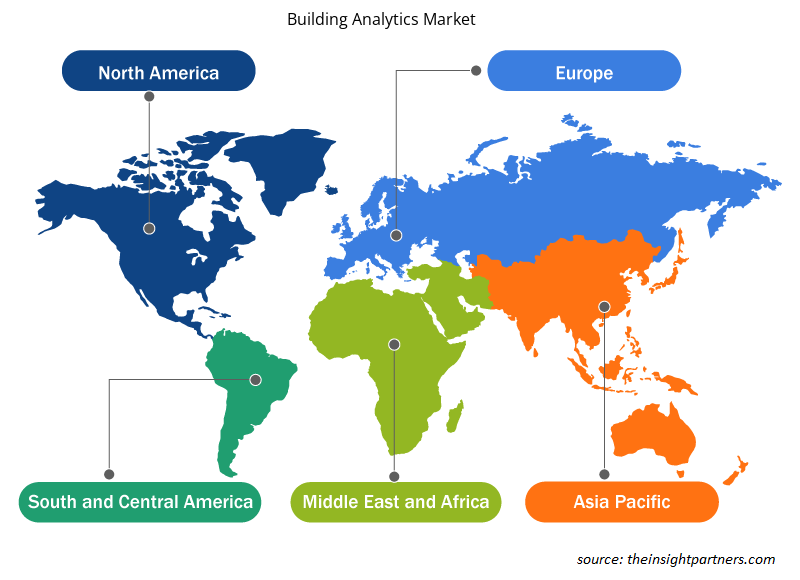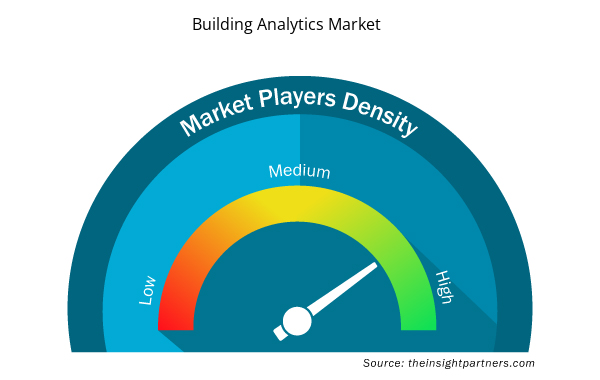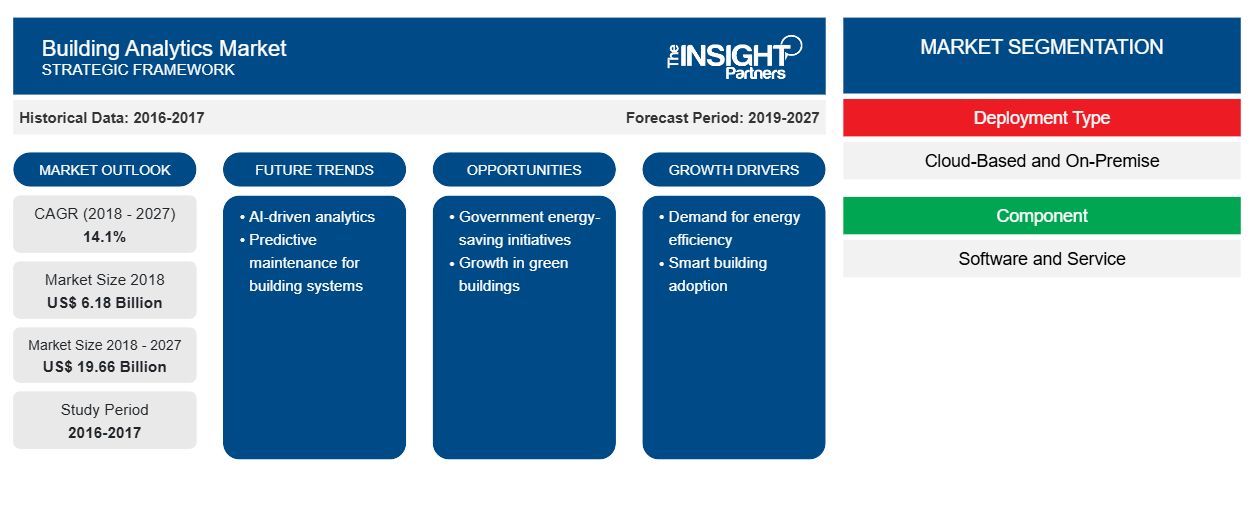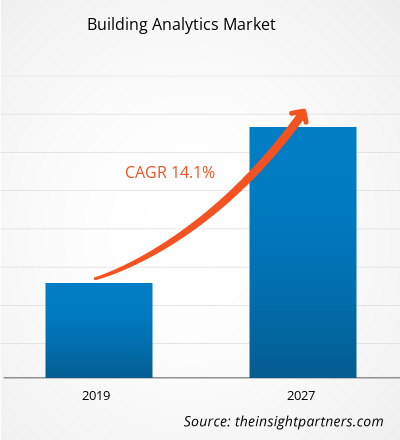Nel 2018, il mercato globale dell'analisi edilizia è stato valutato 6.181,4 milioni di dollari e si prevede che crescerà a un CAGR del 14,1% tra il 2019 e il 2027.
Il mercato dell'analisi degli edifici sta registrando una crescita in tutto il mondo; si prevede che l'aumento dei prezzi dell'energia, le linee guida sempre più severe in materia di energia negli edifici e il raggiungimento della massima efficienza operativa per la gestione degli edifici e delle strutture saranno i principali motori del mercato nei prossimi anni.
Il rapporto si concentra su una segmentazione approfondita del mercato dell'analisi degli edifici in base al tipo di distribuzione, componente, tipo di edificio e applicazione. La segmentazione geografica del rapporto copre cinque regioni principali, tra cui: Nord America, Europa, Asia-Pacifico (APAC), Medio Oriente e Africa (MEA) e Sud America (SA). Il mercato regionale è stato ulteriormente segmentato in base ai rispettivi paesi. Per applicazione, la gestione dell'energia ha rappresentato la quota maggiore nel mercato dell'analisi degli edifici nel 2018.
Personalizza questo report in base alle tue esigenze
Riceverai la personalizzazione gratuita di qualsiasi report, comprese parti di questo report, o analisi a livello nazionale, pacchetto dati Excel, oltre a usufruire di grandi offerte e sconti per start-up e università
- Scopri le principali tendenze di mercato in questo rapporto.Questo campione GRATUITO includerà analisi di dati che spaziano dalle tendenze di mercato alle stime e alle previsioni.
Il rapporto mira a fornire una panoramica del mercato globale dell'analisi degli edifici con una segmentazione di mercato dettagliata. Inoltre, analizza l'attuale scenario del mercato dell'analisi degli edifici e prevede il mercato fino al 2027. Il rapporto copre le dinamiche di mercato che influenzano il mercato dell'analisi degli edifici durante il periodo di previsione. Inoltre, il rapporto analizza lo scenario competitivo, le tendenze geografiche e le opportunità nel mercato dell'analisi degli edifici rispetto a tutte le regioni geografiche. Il rapporto include anche i profili aziendali dettagliati dei principali attori nel mercato dell'analisi degli edifici insieme alle loro strategie di mercato. Il rapporto fornisce anche PEST insieme all'analisi SWOT per tutte le aziende profilate nel rapporto.
Attualmente, i tassi di penetrazione del mercato dell'analisi degli edifici nella regione europea sono più alti rispetto a qualsiasi altro mercato nel mondo. La direttiva sull'efficienza energetica dell'Unione europea, lanciata nel 2012, ha stabilito una serie di misure obbligatorie per aiutare l'UE a raggiungere il suo obiettivo di efficienza energetica del 20% entro il 2020. La direttiva richiede a tutti i paesi dell'UE di utilizzare l'energia in modo più efficiente lungo tutta la filiera energetica, ovvero dalla produzione al consumo finale. Inoltre, nel 2016, è stato proposto un aggiornamento della direttiva sull'efficienza energetica, che includeva un nuovo obiettivo di efficienza energetica del 30% per il 2030, nonché misure per soddisfare il nuovo obiettivo. Nell'UE, gli edifici rappresentano circa il 40% del consumo energetico totale e il 36% delle emissioni totali di CO2. Inoltre, circa il 35% degli edifici nell'UE ha più di 50 anni e quasi il 75% del patrimonio edilizio è inefficiente dal punto di vista energetico, sebbene solo lo 0,4-1,2% del patrimonio edilizio venga ripristinato ogni anno. Pertanto, un maggiore ripristino degli edifici esistenti ha la prospettiva di portare a notevoli risparmi energetici. Tali fatti offrono una prospera opportunità di crescita per il mercato dell'analisi edilizia.
Analisi di mercato degli edifici, approfondimenti regionali
Le tendenze regionali e i fattori che influenzano il Building Analytics Market durante il periodo di previsione sono stati ampiamente spiegati dagli analisti di Insight Partners. Questa sezione discute anche i segmenti e la geografia del Building Analytics Market in Nord America, Europa, Asia Pacifico, Medio Oriente e Africa e Sud e Centro America.

- Ottieni i dati specifici regionali per il mercato dell'analisi degli edifici
Ambito del rapporto di mercato sull'analisi degli edifici
| Attributo del report | Dettagli |
|---|---|
| Dimensioni del mercato nel 2018 | 6,18 miliardi di dollari USA |
| Dimensioni del mercato entro il 2027 | 19,66 miliardi di dollari USA |
| CAGR globale (2018 - 2027) | 14,1% |
| Dati storici | 2016-2017 |
| Periodo di previsione | 2019-2027 |
| Segmenti coperti | Per tipo di distribuzione
|
| Regioni e Paesi coperti | America del Nord
|
| Leader di mercato e profili aziendali chiave |
|
Creazione di densità di attori del mercato dell'analisi: comprendere il suo impatto sulle dinamiche aziendali
Il mercato Building Analytics Market sta crescendo rapidamente, spinto dalla crescente domanda degli utenti finali dovuta a fattori quali l'evoluzione delle preferenze dei consumatori, i progressi tecnologici e una maggiore consapevolezza dei vantaggi del prodotto. Con l'aumento della domanda, le aziende stanno ampliando le loro offerte, innovando per soddisfare le esigenze dei consumatori e capitalizzando sulle tendenze emergenti, il che alimenta ulteriormente la crescita del mercato.
La densità degli operatori di mercato si riferisce alla distribuzione di aziende o società che operano in un particolare mercato o settore. Indica quanti concorrenti (operatori di mercato) sono presenti in un dato spazio di mercato in relazione alle sue dimensioni o al valore di mercato totale.
Le principali aziende che operano nel mercato dell'analisi degli edifici sono:
- Schneider elettrico
- Società per azioni International Business Machines (IBM)
- Fonderia del cielo
- Sistemi Ambientali, Inc.
- Servizi di ENGIE Insight Inc.
Disclaimer : le aziende elencate sopra non sono classificate secondo un ordine particolare.

- Ottieni una panoramica dei principali attori del mercato Building Analytics
Tra i principali attori che operano in questo mercato figurano (in ordine alfabetico): Acorn Engineering Group Limited, Arup Group, AT Kearney, Buildingiq, Buildinglogix, Buildpulse, Coppertree Analytics, Crestron Electronics, Delta Electronics, Ecovox, Energy Advantage, Enernoc, Engie Insight, Environmental Systems Inc., General Electric, Gooee, Gridpoint, Honeywell, IBM Corporation, Iconics, Schneider Electric, Senseware, Siemens, SkyFoundry, Waibel Energy Systems, Xchanging PLC (CSC Computer Sciences International Operations Limited), tra gli altri.
- Analisi storica (2 anni), anno base, previsione (7 anni) con CAGR
- Analisi PEST e SWOT
- Valore/volume delle dimensioni del mercato - Globale, regionale, nazionale
- Industria e panorama competitivo
- Set di dati Excel



Report Coverage
Revenue forecast, Company Analysis, Industry landscape, Growth factors, and Trends

Segment Covered
This text is related
to segments covered.

Regional Scope
North America, Europe, Asia Pacific, Middle East & Africa, South & Central America

Country Scope
This text is related
to country scope.
Trends and growth analysis reports related to Technology, Media and Telecommunications : READ MORE..
The List of Companies
1. Schneider Electric
2. International Business Machines (IBM) Corporation
3. SkyFoundry
4. Environmental Systems, Inc.
5. ENGIE Insight Services Inc
6. Senseware, Inc.
7. Gooee
8. Acorn Engineering Group Limited
9. Waibel Energy Systems
10. BuildingIQ, Inc
11. Siemens AG
12. General Electric (GE)
13. Iconics, Inc.
14. Coppertree Analytics
15. Delta Electronics
The Insight Partners performs research in 4 major stages: Data Collection & Secondary Research, Primary Research, Data Analysis and Data Triangulation & Final Review.
- Data Collection and Secondary Research:
As a market research and consulting firm operating from a decade, we have published and advised several client across the globe. First step for any study will start with an assessment of currently available data and insights from existing reports. Further, historical and current market information is collected from Investor Presentations, Annual Reports, SEC Filings, etc., and other information related to company’s performance and market positioning are gathered from Paid Databases (Factiva, Hoovers, and Reuters) and various other publications available in public domain.
Several associations trade associates, technical forums, institutes, societies and organization are accessed to gain technical as well as market related insights through their publications such as research papers, blogs and press releases related to the studies are referred to get cues about the market. Further, white papers, journals, magazines, and other news articles published in last 3 years are scrutinized and analyzed to understand the current market trends.
- Primary Research:
The primarily interview analysis comprise of data obtained from industry participants interview and answers to survey questions gathered by in-house primary team.
For primary research, interviews are conducted with industry experts/CEOs/Marketing Managers/VPs/Subject Matter Experts from both demand and supply side to get a 360-degree view of the market. The primary team conducts several interviews based on the complexity of the markets to understand the various market trends and dynamics which makes research more credible and precise.
A typical research interview fulfils the following functions:
- Provides first-hand information on the market size, market trends, growth trends, competitive landscape, and outlook
- Validates and strengthens in-house secondary research findings
- Develops the analysis team’s expertise and market understanding
Primary research involves email interactions and telephone interviews for each market, category, segment, and sub-segment across geographies. The participants who typically take part in such a process include, but are not limited to:
- Industry participants: VPs, business development managers, market intelligence managers and national sales managers
- Outside experts: Valuation experts, research analysts and key opinion leaders specializing in the electronics and semiconductor industry.
Below is the breakup of our primary respondents by company, designation, and region:

Once we receive the confirmation from primary research sources or primary respondents, we finalize the base year market estimation and forecast the data as per the macroeconomic and microeconomic factors assessed during data collection.
- Data Analysis:
Once data is validated through both secondary as well as primary respondents, we finalize the market estimations by hypothesis formulation and factor analysis at regional and country level.
- Macro-Economic Factor Analysis:
We analyse macroeconomic indicators such the gross domestic product (GDP), increase in the demand for goods and services across industries, technological advancement, regional economic growth, governmental policies, the influence of COVID-19, PEST analysis, and other aspects. This analysis aids in setting benchmarks for various nations/regions and approximating market splits. Additionally, the general trend of the aforementioned components aid in determining the market's development possibilities.
- Country Level Data:
Various factors that are especially aligned to the country are taken into account to determine the market size for a certain area and country, including the presence of vendors, such as headquarters and offices, the country's GDP, demand patterns, and industry growth. To comprehend the market dynamics for the nation, a number of growth variables, inhibitors, application areas, and current market trends are researched. The aforementioned elements aid in determining the country's overall market's growth potential.
- Company Profile:
The “Table of Contents” is formulated by listing and analyzing more than 25 - 30 companies operating in the market ecosystem across geographies. However, we profile only 10 companies as a standard practice in our syndicate reports. These 10 companies comprise leading, emerging, and regional players. Nonetheless, our analysis is not restricted to the 10 listed companies, we also analyze other companies present in the market to develop a holistic view and understand the prevailing trends. The “Company Profiles” section in the report covers key facts, business description, products & services, financial information, SWOT analysis, and key developments. The financial information presented is extracted from the annual reports and official documents of the publicly listed companies. Upon collecting the information for the sections of respective companies, we verify them via various primary sources and then compile the data in respective company profiles. The company level information helps us in deriving the base number as well as in forecasting the market size.
- Developing Base Number:
Aggregation of sales statistics (2020-2022) and macro-economic factor, and other secondary and primary research insights are utilized to arrive at base number and related market shares for 2022. The data gaps are identified in this step and relevant market data is analyzed, collected from paid primary interviews or databases. On finalizing the base year market size, forecasts are developed on the basis of macro-economic, industry and market growth factors and company level analysis.
- Data Triangulation and Final Review:
The market findings and base year market size calculations are validated from supply as well as demand side. Demand side validations are based on macro-economic factor analysis and benchmarks for respective regions and countries. In case of supply side validations, revenues of major companies are estimated (in case not available) based on industry benchmark, approximate number of employees, product portfolio, and primary interviews revenues are gathered. Further revenue from target product/service segment is assessed to avoid overshooting of market statistics. In case of heavy deviations between supply and demand side values, all thes steps are repeated to achieve synchronization.
We follow an iterative model, wherein we share our research findings with Subject Matter Experts (SME’s) and Key Opinion Leaders (KOLs) until consensus view of the market is not formulated – this model negates any drastic deviation in the opinions of experts. Only validated and universally acceptable research findings are quoted in our reports.
We have important check points that we use to validate our research findings – which we call – data triangulation, where we validate the information, we generate from secondary sources with primary interviews and then we re-validate with our internal data bases and Subject matter experts. This comprehensive model enables us to deliver high quality, reliable data in shortest possible time.


 Ottieni un campione gratuito per questo repot
Ottieni un campione gratuito per questo repot